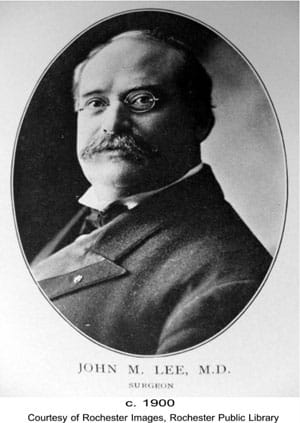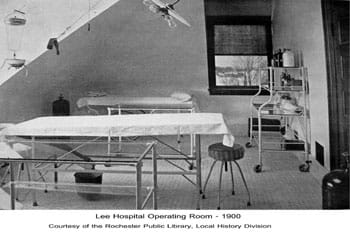General Content
 One major innovation of the hospital was its treatment of cancer with an early form of nuclear medicine. In August 1922, a radium emanation plant and therapeutic deep therapy X-ray equipment was installed in the hospital. Dr. Lee’s close association with Dr. G. Faill, a renowned physicist of the Memorial Hospital in New York City who had spearheaded the treatment of malignant tumors with the use of radium and deep therapy X-ray, led to the purchase and installation of the equipment. This equipment was the first of its kind in Rochester and only one of twelve in service in the nation.
One major innovation of the hospital was its treatment of cancer with an early form of nuclear medicine. In August 1922, a radium emanation plant and therapeutic deep therapy X-ray equipment was installed in the hospital. Dr. Lee’s close association with Dr. G. Faill, a renowned physicist of the Memorial Hospital in New York City who had spearheaded the treatment of malignant tumors with the use of radium and deep therapy X-ray, led to the purchase and installation of the equipment. This equipment was the first of its kind in Rochester and only one of twelve in service in the nation.
Radium therapy, the most advanced cancer treatment available in the 1920s, consisted of destroying cancerous cells by injecting radium emanation into the tumor followed by the use of deep therapy x-ray waves to destroy any remaining cancerous cells. As a last resort, surgery would remove any remaining diseased tissue. Radium treatment required the use of small glass tubes called Capillaries to the inject radium emanation into the tumors. Dr. Lee developed the capillaries, and by the mid-1920s, they were in use nationwide. Dr. Lee’s commitment to the community and deep personal sense of compassion led him to open the only free radium clinic in Rochester. The clinic was open on Fridays to anyone needing the treatment. Quite often patients did not require surgery, which allowed the individuals to continue their normal routines. When hospital stays were required, patients only paid “for the bed and hospital expenses, and not for the care by physicians.”
 Dr. Lee utilized deep therapy X-ray as both an alternative and a supplement to radium treatment. Where the radiation wavelengths of the radium were short and most effective in treating specific smaller areas around the tumors, the X-ray waves were longer and could affect a larger surface area. Commenting in a local newspaper article, Dr. Lee explained the advantage of this new technology:
Dr. Lee utilized deep therapy X-ray as both an alternative and a supplement to radium treatment. Where the radiation wavelengths of the radium were short and most effective in treating specific smaller areas around the tumors, the X-ray waves were longer and could affect a larger surface area. Commenting in a local newspaper article, Dr. Lee explained the advantage of this new technology:
The day will come when the surgeon cannot conscientiously recommend the knife [surgery] in cases where he formally did. In certain cases, I still would recommend an operation, supplementing this form of surgery with radiation. The combined methods make it, in my opinion, complete surgery. These poor people who come here diseased are entitled to the best treatment to be had.
The application of this early form of nuclear medicine symbolized a bold and innovative advancement for such a small private hospital.